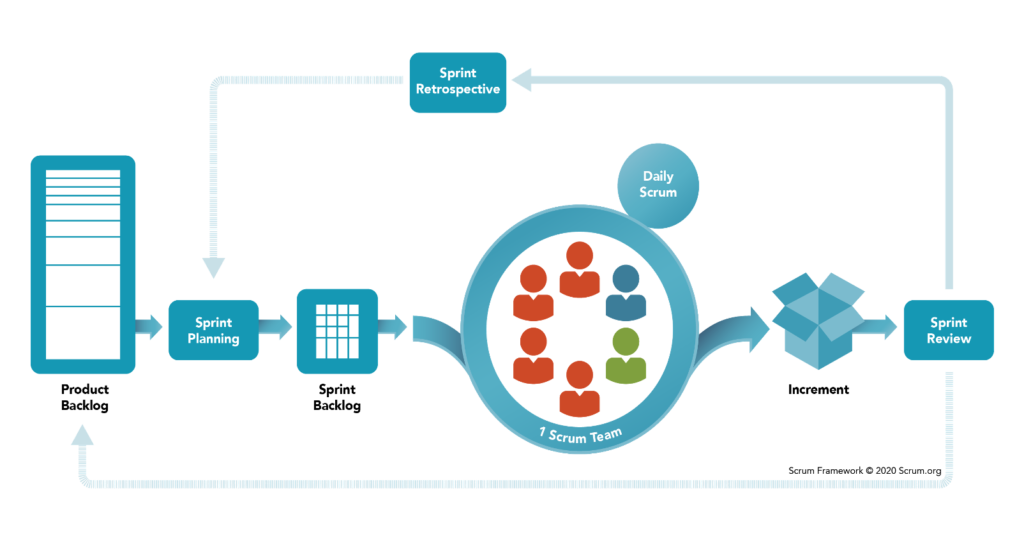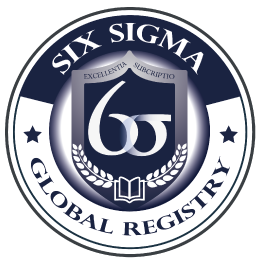Certified Scrum Master
scrumis a lightweight, agile software development methodology that can be used to manage and control software and product development using repeatable or iterative and incremental practices. Scrum brings the benefits of agile development with the benefits of a simple application. This methodology can significantly increase productivity and reduce time to profit while facilitating empirical and adaptive systems development. Scrum brings together cross-functional teams that are responsible for delivering projects that meet dynamic customer expectations. A team is made up of members from Account Development, Product Development, Project Management, IT Development, and Quality Assurance.
AScrum Masteris a person responsible for setting up the team for success. The Scrum Master organizes the Sprint planning meeting which are short and repeatable work cycles usually from 1 week to 30 days. The Scrum Master also plans the Sprint Review Meeting, shielding the team from external disturbances, holding short meetings known as "Daily Scrum", and removing obstacles that may arise in the project.
Each of these meetings is repeated every Sprint cycle and are each designed to facilitate agile development that meets and exceeds customer expectations. The Product Planning meeting has the purpose of determining what the customer wants, at this point in the process. In this meeting, the client sits down with the Scrum team to design the requirements for what is going to be developed during the next Sprint cycle. It is possible and likely that the client's requirements have changed since they originally signed a contract, but cyclical meetings with the client can ensure that the final version will meet the dynamic requirements of the client.
Not understanding the real needs of customers is probably the most common reason for project failure. Requirements bugs are also the most expensive to fix – these bugs can easily consume 25% to 40% of a project budget.
Agile methodologies like Scrum tackle the problem by using an iterative and incremental approach. The Agile approach has made it possible to work closely with the client, understand the needs and implement the functionality progressively and in collaboration with all stakeholders.

At the same time, one of the main goals of using Scrum with Six Sigma tools is to align business goals with customer requirements with tools that address customer expectations and provide valuable insights to address them. This leads to the conclusion that Six Sigma tools and techniques, if used in conjunction with the agile process, can improve efficiency by identifying the real needs of customers by delivering a methodological application to the activities of the Scrum framework. .
The Scrum Master Certification (SMC™) prepares professionals to be facilitators who ensure that the Scrum team is provided with an enabling environment to successfully complete the project. This guides, facilitates and teaches the practices of Scrum to all those involved in the project; clears impediments for the team; and ensures that Scrum processes are being followed.
- Know the philosophy that supports Scrum
- Know the practices of Scrum
- Know the activities of the Scrum Master
- Prepare to perform the role of Scrum Master
- Prepare for the certification exam as a Scrum Master
This course is intended for professionals interested in gaining a working understanding of Scrum and planning to become a Scrum Master. This would include Scrum team members, Product Owners, Product Managers, Project Managers, Project Promoters, Programmers, Designers, Testers, Software Engineers, Executives, Entrepreneurs, Business Analysts and more.
Seminar-Workshop with master classes presenting the concepts of Scrum with the experiences of the instructor using practical cases for the understanding of the concepts and principles of each topic, taking into account common situations in different projects. All accompanied by the corresponding audiovisual aids.
- It helps reduce costs by improving the efficiency of your equipment, activities and processes.
- It will help you win projects with your qualified employees.
- It will improve employee satisfaction by encouraging them to receive training and learn.
- It will improve the quality of its services and customer satisfaction.
- It helps reduce costs by improving the efficiency of your equipment, activities and processes.
- It will help you win projects with your qualified employees.
- It will improve employee satisfaction by encouraging them to receive training and learn.
- It will improve the quality of its services and customer satisfaction.
- Comply with the total hours of training
- Take a Scrum Master certification exam with a 95% pass rate
Scrum Master Certified (SMC™) professionals are facilitators who ensure that the Scrum Team is provided with a conducive environment to successfully complete the project. This course provides guidelines for the management of all those involved in the project; clears obstacles for the team; and, ensure that the Scrum processes are being followed.
- instructors

- Systems Engineer from the University of Massachusetts - Lowell with specializations in Process Engineering and Robotics.
- Postgraduate degree in Information Technology Administration from the University of Phoenix.
- Six Sigma Black Belt certified by Sunbeam Jarden Consumer Solutions company in 2005 with recertification in 2006, 2007 and 2008.
- Certified in Advanced Problem Solving and Root Cause Analysis/FMEA by Worcester Polytechnic Institute.
- SQA/ORT Quality Auditor in Asia and Latin America.
- Synergy Technology Solutions Associate Instructor for Six Sigma and Lean Manufacturing.
- Member of the Colombian Society of Six Sigma (Acosixsigma) of which he is an active contributor to the Tools and Tactics section of the members' area.
- He currently serves as president of the same organization.

- Specialist in Project Management from the National Open and Distance University.
- Industrial Engineer from the Technological University of Pereira.
- Certified Scrum Master, International Six Sigma Black Belt certification and Master Black Belt from Six Sigma Global Registry.
- Yellow Belt Instructor, Green Belt, Black Belt and Master Black Belt for Acosixsigma.
- Responsible for the implementation of performance management models, design of strategic maps, application of Kaizen accelerated improvement events and analysis of production processes in fundamental practices.
- Experience with more than 200 Belts trained in Colombia and Latin America. He has actively participated in the implementation of more than 100 projects with savings of more than 300 million dollars since 2014.
- He currently works as Project Coordinator and Senior Consultant at the Colombian Society of Six Sigma – Acosixsigma.
Information request
Latin America
USA and Europe

Investment value
- Intensity: 16 Hours.
- Scrum Theory
- Tools that allow better implementation
- Didactic materials
- Exam tests and online exercises
- In-person practice workshop
- Proctored Scrum Master Exam
- International Certification by Scrum Study
- 1 year membership in SigmaNet for support materials, seminars, forums, free seminars and discounts on Six Sigma and Operational Excellence activities.
- Virtual monitoring of certification projects in Project Manager for 12 months once the in-person training is completed.
- Attendance certificate
- Certification Exam administered by Six Sigma Global Registry
- Permanent registration in Six Sigma Global Registry for verification of certification recognized in 165 countries.
- Memories of the presentations.
Leave us your data to advise you!
FAQ
According to the Body of Knowledge (BOK) of the American Society for Quality (ASQ) and the international certification programs recognized by Motorola University and the International Society for Six Sigma Certifications, the minimum hour number of the Six Sigma program is: There are a number of Six Sigma programs that are widely marketed and apply only a fraction of the BOK for each level. Acosixsigma is recognized for the large amount of curricular content that applies to all types of industry. For example, the estimated time for a Black Belt certification course is 120 hours, not including additional time allocated to a Six Sigma project. Other providers offer Black Belt training courses totaling 90 hours and Green Belt courses advertised at 56 hours. Therefore the variability in class hours obviously serves as a warning for interested companies to carefully check the subjects when taking a particular course against the established criteria for certification.
A Lean/Kaizen/Blitz Event is an intense effort where the team applies specific Lean approaches to reduce waste, defects, and cycle time and to implement improvements in a particular process or department.
Lean Six Sigma is an integrated set of methodologies that encompasses both Lean and Six Sigma concepts. It combines two powerful toolsets to address all aspects of quality, cost, and delivery. Both sets of methodologies have a customer and quality focus and are based on continuous improvement, which allows them to be very complementary.
Lean focuses on offering competitively priced products and services by eliminating waste and its drivers, while Six Sigma focuses on minimizing and reducing process variation that causes nonconformities.
Lean Six Sigma combines the strength and rigor of Six Sigma and data-driven analysis with the simple tools of Lean to eliminate waste and its drivers. The combination of the two methods provides a more robust set of tools for organizations to apply to solve problems, using the tools and techniques that best suit the specific problem at hand. Rather than the traditional independent use of tools, Lean Six Sigma combines Lean approaches into Six Sigma through the DMAIC (Define, Measure, Analyze, Improve and Control) method, as well as allowing Lean approaches to be used on their own. in the DMAIC model.
Process improvement is necessary for the performance of an organization that does not meet customer requirements. Lean Six Sigma offers a comprehensive set of tools, techniques, and approaches to enable an organization to gather customer requirements, analyze existing performance against those requirements, implement solutions to address performance gaps, and maintain best-in-class status. The tools and techniques used are the most appropriate for the specific problem at hand.

